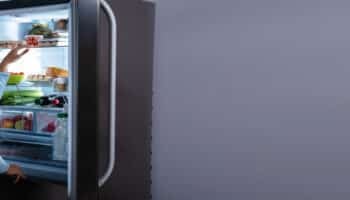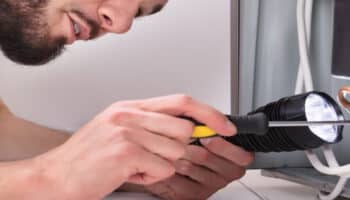Is your refrigerator freezing everything, and you have no clue why?
Don’t worry – you’re not alone. Every day, thousands of homeowners go through the same problem and are left nothing short of confused. Thankfully, the fixes for a frozen refrigerator can be quite simple.
If your fridge keeps freezing everything, try turning the thermostat right down, de-icing the drainage hole, checking the door gasket, cleaning the evaporator coils, and ensuring the fridge has at least 2 inches of breathing room on all sides and is level.
Ready to get your fridge back to normal? Let’s go!
Why trust us? This article was written by Craig Anderson and Andy Fulenchek.
Craig has helped thousands of other homeowners repair their appliances since 2016.
Andy is one of our resident appliance repair experts with over a decade of experience. He currently runs his appliance repair company with a team of trusted technicians.
Fixing A Fridge That Freezes Everything
There are many reasons why your refrigerator is freezing your food. To get to the bottom of the issue, knowing the main causes and solutions is critical. Here’s what I check first.
Clogged Drainage Pipe
I find that the most common thing that causes a fridge to keep freezing everything is drainage clogging.
At the base of every fridge’s interior is often a drainage hole for any water or condensation to collect and pass out of the fridge. The drainage hole can often get frozen if the fridge is cold enough and has a freezer component beneath it.
Once frozen, additional water will also begin to freeze and eventually lower the temperature of the whole fridge. To fix a frozen drain pipe, you can try pouring some warm water onto the drainage hole to try and melt the blockage. However, the best fix is turning the fridge off entirely long enough for everything to melt.
Improper Fridge Setup
If your fridge keeps freezing everything, chances are it’s not level.
A fridge isn’t a magical cooling box – it’s an appliance that relies on a fairly complex refrigeration process that mainly depends on 2 things:
- To be on a level surface, so the refrigerant and gas flow properly.
- Enough air around it to exhaust and operate properly.
Use a spirit level to ensure your fridge is standing level, and make sure it has a good amount of air around it to dissipate heat properly.
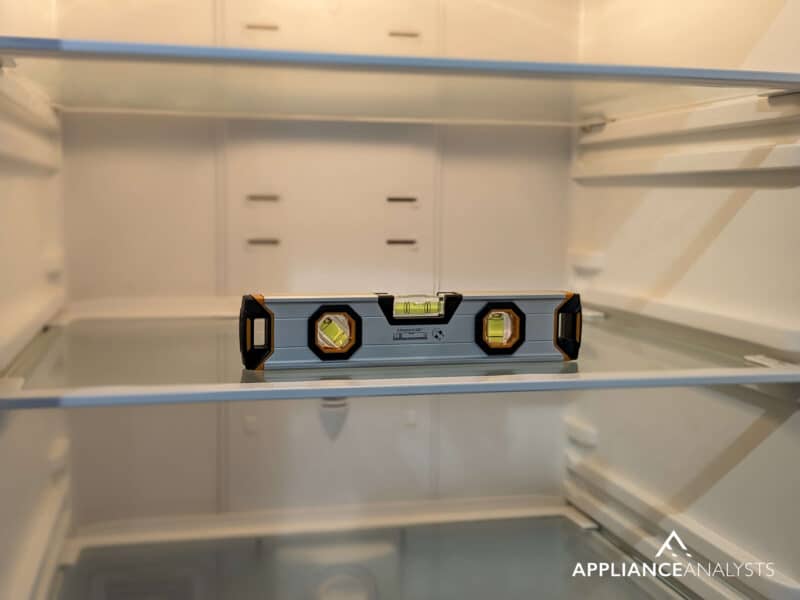
The Thermostat Is Set Too High
If your thermostat is set too high, your fridge will naturally run colder than you need, causing it to freeze your food.
The thermostat can be set too high either due to user error or appliance failure.
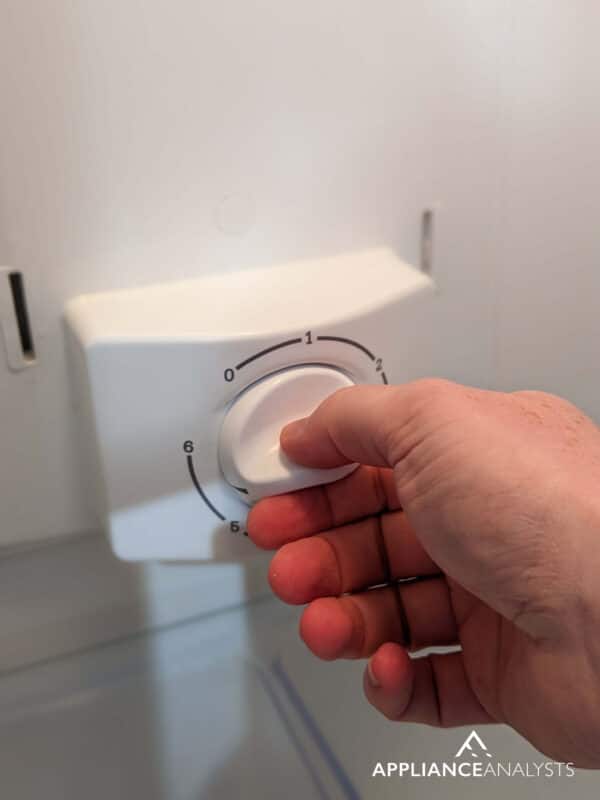
If you tend to crank up your refrigerator’s settings when the holidays come, and your appliance is filled to the brim, it could be causing your food to freeze over. Typically, there are standard thermostat settings recommended by your manufacturer to keep your food perfectly preserved without icing over.
Please refer to your User Manual to find the recommended settings.
The Thermostat Needs Replacing
If your refrigerator is freezing your food, it could also be due to a failing thermostat.
The basic concept of the thermostat is active temperature control. When the refrigerator gets too warm, the thermostat kicks in the compressor to start the cooling process again. When the fridge gets too cold, the opposite happens: the compressor is turned off and lets the temperature in the appliance sit for a while.
Temperature regulation is an ongoing process. But if you’ve already ensured the thermostat is not set at freezing levels, my usual advice is to check the part for a fault. You’ll have to find your wiring diagram (typically in the compressor compartment) and hook up a digital multimeter to test the electrical function of the thermostat.
Older fridges have a mechanical temperature sensor with an on/off switch that can fail and explain your current situation, whereas newer models read their temperature via a control board. While you can’t test the switches in an older refrigerator with a multimeter, you can do so with the control board on newer ones.
If you’re comfortable with wiring diagrams and a digital multimeter, you shouldn’t have difficulty testing the thermostat and temperature sensors. However, if you don’t like playing with complex tools (or if the wiring diagram is just confusing to you), I recommend calling a professional.
If you want to tackle the issue yourself, here’s what you must do.
Once the digital multimeter is hooked up correctly, following the wiring diagram, the multimeter needs to be cycled through, checking the readings from the “Off” position to the coldest setting. The owner’s manual and wiring diagram will tell you what readings you should see.
In the “Off” position, the multimeter should display O.L (or open circuit). As the multimeter is rotated from “Off” it should read “0.00”. If the multimeter reads “0.00” in the “Off” position or if it never switches from O.L. to “0.00” then you have a thermostat/temperature sensor switch that needs replacing.
The Refrigerator Door Gasket is Bad
A damaged door gasket could also explain why your refrigerator is freezing your food.
The gasket on your refrigerator door creates an airtight seal inside the appliance’s compartment, keeping temperatures regulated.
To check the gasket, go to your refrigerator and open the door. On the inside of the door, you’ll see a rubber gasket that runs all the way around the door’s exterior.
If the gasket’s damaged, loose, or warped in any way, it will fail to seal properly.
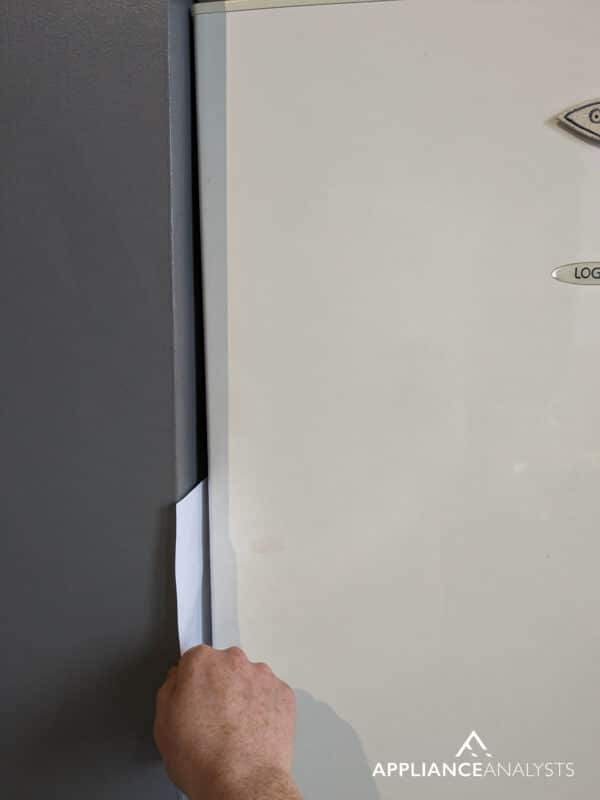
If the door doesn’t form an adequate enough seal with the refrigerator’s main body, the interior environment of the fridge becomes compromised.
A bad seal can cause the fridge to constantly run because the seal is allowing the fridge to run as if the door were wide open.
From what I’ve seen over the years, modern refrigerators will cycle off if the door is open for too long. But if the door is shut and the seal is bad, there’s just enough of a compromise that the refrigerator will not shut off, even though it’s losing cold air through the bad seal.
If the refrigerator is consistently losing air through the seal, it will continue to run and run, eventually freezing everything.
You can inspect the gasket by looking for the following:
- Tears: Check the corners, carefully noting the hinge side where the part of the gasket receives the most work whenever the door is opened and closed.
- Dirt and grime buildup: Food residue and gunk accumulate in and around your refrigerator over time. Sooner or later, some of the residues will stick to the gasket, preventing your fridge door from closing properly. Give the gasket a good cleaning at least once every 2 months.
If the gasket looks good, you can check for a proper seal by placing a thin sheet of paper on the door. If the paper can be easily pulled out with the door closed, you’re not getting a proper seal.
If you want to get any replacement part – or see how much one would cost – click to enter your model number in the search bar below. Our partners at AppliancePartsPros stock almost every part with free guides on how to install them.

Damper Door Issues
If your refrigerator keeps freezing your food, it can also be due to damper door issues.
The damper door helps your fridge and freezer compartment share cool air when necessary, regulating the appliance’s internal temperatures.
When there’s something wrong with the damper door, it won’t close properly, letting too much of the freezer’s air go into the refrigeration compartment, freezing everything there. In most cases, such a fault can be blamed on a defective damper door motor that will need testing and replacing.
Dirty Coils
If your condenser/evaporator coils are dirty, it would also explain why your fridge keeps freezing everything.
Cleaning your refrigerator’s coils is a good practice that should be implemented by all fridge owners. The evaporator coils are located in the rear of the refrigerator and play a key role in heat dissipation.
On older models, the coils are exposed and very easy to see, but on more modern variants, they’re enclosed. If the coils are dirty or dusty, they’ll have to work harder to keep the refrigerator cold, leading to unexpected freezing in the refrigerator itself. And the same goes for the vents in the appliance.
Do your best to clean your refrigerator at least twice a year thoroughly.
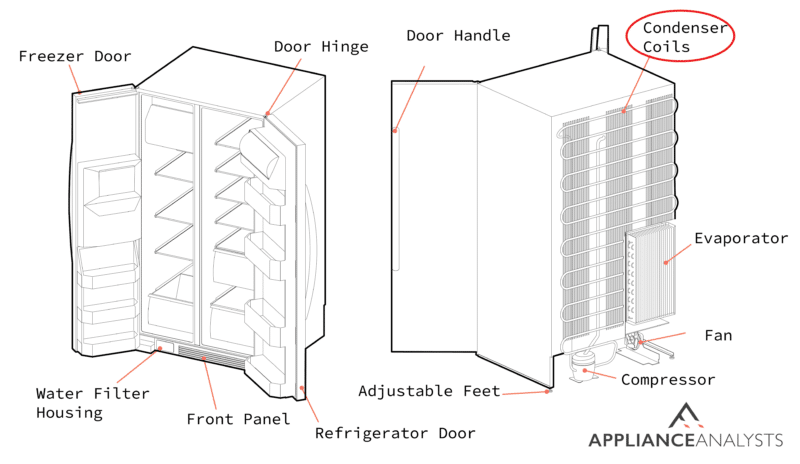
Repairing a Fridge That’s Freezing Everything
When your fridge is freezing everything inside its compartment, your food can spoil beyond repair and ruin your dinner plans.
Luckily, as I hope this piece has helped you better understand, addressing the most common causes behind a refrigerator that keeps freezing your food is easy and quick. More often than not, something as simple as checking the gasket and the damper door motor will do the trick.
Thanks for reading. If this article was useful, please check out our other resources below and consider subscribing to our newsletter.
Have a great day!
-Craig.








